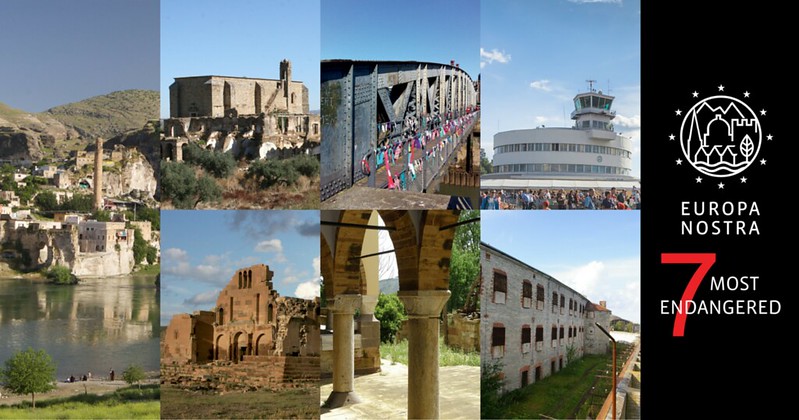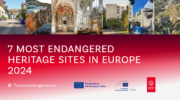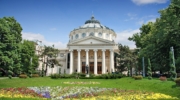Europe’s 7 Most Endangered heritage sites 2016 announced
The Hague / Luxembourg, 16 March 2016 – The Archaeological site of Ererouyk and the village of Ani Pemza in Armenia, Patarei Sea Fortress in Tallinn in Estonia, Helsinki-Malmi Airport in Finland, Colbert Swing Bridge in Dieppe in France, the Kampos of Chios in Greece, the Convent of St. Anthony of Padua in Extremadura in Spain, and the Ancient city of Hasankeyf and its surroundings in Turkey have been named as the 7 Most Endangered heritage sites in Europe in 2016. Europa Nostra, the leading European heritage organisation, and the European Investment Bank Institute (EIBI) made the announcement today during a public event at the Ateneo Veneto in Venice, Italy.
These gems of Europe’s cultural heritage are in serious danger, some due to lack of resources or expertise, others due to neglect or inadequate planning. Urgent action is therefore needed. Expert missions to the sites will be arranged and feasible action plans submitted by the end of the year. ‘The 7 Most Endangered’ has the support of the Creative Europe programme of the European Union, as part of Europa Nostra’s network project ‘Mainstreaming Heritage’.
In addition, Europa Nostra and the EIB Institute – following a firm recommendation from an international advisory panel of experts – decided that the Venice Lagoon in Italy should be declared the most endangered heritage site in Europe, given the paramount importance of this heritage landmark to Europe and the world, as well as the complexity and magnitude of the challenges posed.
Maestro Plácido Domingo, President of Europa Nostra, stated: “This list spotlights rare examples of Europe’s cultural and natural heritage that are at risk of being lost forever. The local communities are firmly engaged in trying to save these testaments to our shared story but need widespread support. On behalf of Europa Nostra, I urge national and European stakeholders, both public and private, to join forces with us to ensure a promising future for these sites. Rescuing our common heritage brings countless social and economic benefits not just for the regions and the countries involved but for Europe as a whole, as has been increasingly recognised by EU institutions and is clearly demonstrated in the recent report ‘Cultural Heritage Counts for Europe’”.
Reacting to the announcement of ‘The 7 Most Endangered’ 2016, Tibor Navracsics, European Commissioner for Education, Culture, Youth and Sport, said: “Our cultural heritage is an integral part of who we are as human beings. We must not take it for granted. On the contrary, we need to cherish and protect it to keep it alive. That is why the EU is working with regions and cities to help them preserve their heritage sites. Our aim is to enable local communities to discover and experience their heritage, and to give them a say in how it is developed and managed. This is a great way of bringing people together, of building open, tolerant societies – something that is today more vital than ever.”
“Well-run cultural and natural heritage projects can bring important economic and social contributions to regional development and to urban renewal throughout Europe. This is the reason why the EIB Institute and the European Commission participate actively in ‘The 7 Most Endangered’ programme,” added Francisco de Paula Coelho, Dean of the EIB Institute.
Europa Nostra and the European Investment Bank Institute, together with other partners and the nominators, will visit the 7 selected sites and meet with key stakeholders in the coming months. The heritage and financial experts will provide technical advice, identify possible sources of funding and mobilise broad support.
The 7 Most Endangered for 2016 were selected by the Board of Europa Nostra from the 14 sites shortlisted by a panel of specialists in history, archaeology, architecture, conservation, project analysis and finance. Nominations were submitted by civil society or public bodies which form part of Europa Nostra’s vast network of member and associate organisations from all over Europe.
‘The 7 Most Endangered’ programme was launched in January 2013 by Europa Nostra with the EIB Institute as founding partner and the Council of Europe Development Bank as associated partner. It was inspired by a successful similar project run by the US National Trust for Historic Preservation. ‘The 7 Most Endangered’ is not a funding scheme. Its aim is to serve as a catalyst for action and to promote “the power of example”.
The first 7 Most Endangered list was presented in June 2013 in Athens, followed by the second in May 2014 in Vienna, during the European Heritage Congresses held by Europa Nostra in the two cities.
The 7 Most Endangered heritage sites in Europe in 2016
(listed in alphabetical order of their country)
Archaeological Site of Ererouyk and village of Ani Pemza, ARMENIA
Ererouyk is a superb monument of Early Christian architecture, an architecture of great variety and distinction, today often subjected to neglect, if not willful destruction, in most of its original homeland around the Eastern Mediterranean. Armenian religious architecture, amongst the finest and most innovative, is well represented by Ererouyk. The monument dates back to the 6th century and lies on a rocky plateau close to the river that forms the border with Turkey, in the vicinity of the ancient capital Ani. All around the three-aisled basilica lay the remains of funerary and other relevant monuments which deserve immediate study and preservation. This is crucial for the understanding of a settlement within a multi-ethnic and multi-cultural framework during the Middle Ages, as demonstrated by relevant archaeological findings that also need to be studied and displayed.
The site is at constant danger from earthquakes, a danger increased by the condition of the monument. Yet, if preserved and well managed, it has the potential to give life to the whole region as a site that will attract visitor, with the nearby Soviet-era style village of Ani Pemza, built in 1926, serving as a potential centre for cultural tourism. The Centre of Studies and Documentation of Armenian Culture in Italy (CSDCA) submitted the nomination for ‘The 7 Most Endangered’ 2016.
Patarei Sea Fortress in Tallinn, ESTONIA
Patarei is a complex of buildings, originally built as a naval fortress under Tsarist rule in 1829-1840. It became a prison between 1920 and 2005, and contains monuments to victims of both Nazi and Stalinist rule. The site is thus closely linked to the sad vicissitudes of Estonia’s recent history. Its rapid deterioration is due to lack of maintenance in harsh climatic conditions.
The Estonian Heritage Society, which made the nomination for ‘The 7 Most Endangered’ 2016, proposes the conversion of Patarei Sea Fortress into a central feature of the adjacent coastline, together with Tallinn Seaplane Harbour, a Grand Prix winner of the EU Prize for Cultural Heritage / Europa Nostra Award in 2013, and the Old Town of Tallinn and the Suomenlinna Fortress in Helsinki, which are both included on UNESCO’s World Heritage List. If restored, the Fortress would serve as a centre for cultural and creative industries and also as a lieu de mémoire.
Helsinki-Malmi Airport, FINLAND
Helsinki-Malmi Airport is a rare surviving example of pre-World War II aviation architecture, built for the 1940 Olympic Games, scheduled to be held in Helsinki but cancelled due to the war.
Malmi Airport, complete with its original hangar, terminal and runways, is still in use with about 40,000 landings per year, offering the only free-schedule international service within 150 km. The area has been declared a cultural environment of national significance by Finland’s National Board of Antiquities. Its open meadow has considerable biodiversity and makes the nature path encircling the site very popular among locals. Helsinki’s new General Plan proposes to fill the airport with apartment blocks to be constructed in the early 2020s, while the state is to withdraw its operations from the airport by the end of 2016.
Following the nomination for ‘The 7 Most Endangered’ 2016, Europa Nostra Finland, supported by the Friends of Malmi Airport (FoMA), seek urgent support to persuade City of Helsinki and Finland’s new government to reverse previous decisions, keep the historic airport, and eventually propose the site for the UNESCO World Heritage List as part of the distinguished functionalist architecture built in Helsinki for the Olympic Games, an idea put forward by the Finnish National Board of Antiquities.
Colbert Swing Bridge in Dieppe, Normandy, FRANCE
The Colbert Bridge, built in 1889, is contemporary with the Eiffel Tower and still functions with its original system of hydraulic pression, carrying about 12,000 vehicles and 1,800 pedestrians daily, makes it an important example of the technical and architectural achievements of the late 19th century. It swings 6 to 8 times each day for the harbour traffic and ensures greater reliability than many modern bridges.
Although one of the earliest examples of “moveable” architecture, a living memory of Dieppe’s cultural and social history and potentially a tourist attraction, its owner, the Syndicat Mixte du Port de Dieppe is planning to demolish it and replace it with a new structure in 2017.
Following a firm recommendation from Dieppe’s Colbert Bridge Protection Committee, the Fondation du Patrimoine submitted the nomination for ‘The 7 Most Endangered’ 2016. The Committee, which is also strongly supported by local public opinion, has requested urgent action to prevent the scheduled demolition through classification of the bridge as a Historic Monument, acceptance of the argument that restoration will be architecturally, socially and environmentally preferable to demolition and, subsequently, the modernisation of the bridge’s mechanism.
Kampos of Chios, island of Chios, GREECE
The Kampos of Chios is a semi-urban, semi-rural area where the islands’ wealthier families built beautiful mansions of local stone, surrounded by citrus orchard estates. The 200 houses and towers which survive, combined with high stone walls separating the estates and narrow surrounding lanes, create a poetic landscape.
The sole surviving example of an originally Genoese colonial order – although frequently rebuilt since the 14th century as a result of earthquakes (as in 1881) – the Kampos is now in danger. Some mansions have been well restored either as homes or as hotels de charme (the Antouaniko received an EU Prize for Cultural Heritage / Europa Nostra Award in 2015). Despite two official preservation decrees however, protection has proven inadequate. Meanwhile the replacement of citrus with the thirstier cultivation of potatoes and vegetables has led to serious problems of water quality and quantity. Other threats are also increasing: “through traffic and the partial demolition of stone boundary walls.
This site of magical beauty requires an inventory of its distinguished buildings and long-term funding of conservation work so as to remain an outstanding example of Europe’s richly varied cultural heritage. Elliniki Etairia ‐ Society for the Environment and Cultural Heritage in collaboration with The Society of Friends of the Kampos of Chios nominated the site for ‘The 7 Most Endangered’ 2016.
Convent of St. Anthony of Padua, Extremadura, SPAIN
The Convent of St. Anthony of Padua near Cáceres comprises a late Gothic church, built in 1476 with some small additions in the Renaissance period and, most notably, others from between 1656 and 1661. The convent lies in the village of Garrovillas de Alconétar, which has a long history and a wealth of monuments; all in danger of dereliction as its inhabitants move on to larger cities.
Given the importance and critical state of the site but also the lack of resources in the current economic situation, Hispania Nostra, which submitted the nomination for ‘The 7 Most Endangered’ 2016, proposes to make the maximum possible use of volunteers in order to restore the convent and other neighbouring monuments. This should prove an inspiring example of broad social participation in the ongoing effort to protect our heritage, a trend as hopeful as it is necessary if the richness of the European cultural tradition is to be preserved.
Ancient city of Hasankeyf and its surroundings, TURKEY
Hasankeyf, sitting on the banks of the River Tigris, is one of the most important architectural and archaeological sites in Europe, boasting a rich biodiversity and 12,000 years of human history. Masterpieces of Islamic architecture, dating from the 12th to 15th centuries C.E., make the town one of the best preserved witnesses to Seljuk urban culture, particularly from the Artukid and Ayyubid dynasties.
A small town with a great heritage, Hasankeyf already attracts about 500.000 visitors each year, a number expected to rise. Given its historical, architectural and economic significance for the region, public opinion supports its preservation. The area was declared a First Degree Archaeological Site by Turkey’s Supreme Board of Monuments in 1978 and has been under the protection of the Culture Ministry’s General Directorate of Antiquities and Museums since 1981.
The urgent threat to Hasankeyf is posed by the Ilisu dam hydroelectric power project which, if implemented as planned, would submerge the site under 65 metres of water by 2018. The Government of Turkey has a vision for salvaging selected monuments and developing the site as a prestigious destination. However, Hasankeyf’s preservation in its original location might prove more economically advantageous than the dam, and its cultural significance for Turkey is incomparable.
The Cultural Awareness Foundation nominated Hasankeyf for ‘The 7 Most Endangered’ 2016 in an attempt to preserve it and to promote dialogue about heritage conservation and sustainability.
In addition, Europa Nostra and the EIB Institute – following a firm recommendation from an international advisory panel of experts – decided that the Venice Lagoonin Italy should be declared the most endangered heritage site in Europe.
Venice Lagoon, ITALY
There could be no Venice and no Venetian civilization without the lagoon. Few historic sites in the world demonstrate so clearly the interdependence of humankind with our environment, of nature with culture.
Yet just as the world contributes to the conservation of monuments in the city, unsustainable development is cutting the physical branch on which Venice has always perched.
Italia Nostra nominated the Venice Lagoon for ‘The 7 Most Endangered’ 2016 as part of a long-term plan to save both the lagoon and the city. In the short-term it proposes: the exclusion of large-scale cruise ships from the lagoon; the suspension of new projects to dredge channels; the cancellation of all major commercial port projects; and the reconstruction of salt marshes. And in the longer term: the transfer of major port activities to Trieste; the rebirth of the abandoned and polluted industrial area of Marghera to become a science and technology park; and incentives to bring inhabitants and companies to Venice. The challenges are huge, demanding a rare combination of conservation, environmental and social sensitivity.
Media Coverage
Press Releases
English
Estonian
Finnish
French
Greek
Italian
Turkish
More Info
http://7mostendangered.eu/
twitter.com/europanostra
Joana Pinheiro
Europa Nostra Communications Officer
jp@europanostra.org
+31 70 302 40 55
Bruno Rossignol
European Investment Bank Institute Officer
bruno.rossignol@eib.org
+352 43 797 07 67








